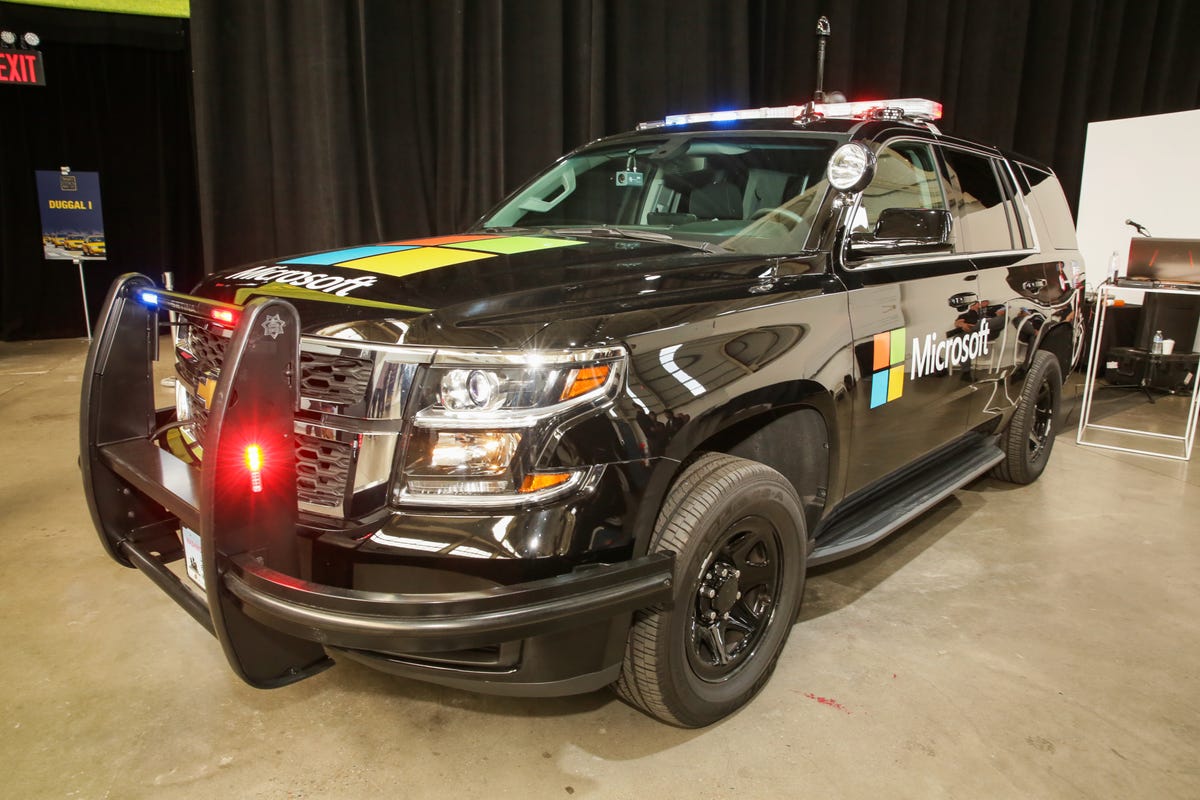This Microsoft police cruiser looks straight out of 'RoboCop'
Smart Cities NYC '17 billed itself as the "first conference and expo that curates the intersection of technology and urban life." We went to the Brooklyn Navy Yard to check it out.

The Microsoft Advanced Patrol Platform (MAPP) vehicle is a Ford Explorer that's been fully stocked with the latest in communications and surveillance gear for law enforcement. Currently in use in both Virginia and Washington state, these vehicles go far beyond your average police car.
A 360-degree camera built by MAGnet Systems is mounted to the roof and sends live video to the cloud and the laptop inside the vehicle. The footage can be navigated, with zoom, controllable from anywhere.
The inside of the MAPP vehicle is fully laden with gear.
The driver can see the vehicle's location on a map, and view footage from the roof camera or click on any other patrol car's feeds.
Using the same camera feed technology, I was shown a live feed from the inside of MAGnet Systems' factory, as accessed from a phone.
From a remote computer, another officer can locate the patrol cars on a larger map, and click into the views from each 360-degree camera. From there, the operator can zoom and navigate to view anything viewable from the car's current location.
This other camera can read a mind-boggling 5,000 license plates per minute. Plate numbers are sent to the cloud, and crosschecked in Azure cloud computing to identify any outstanding warrants or stolen vehicles. Information pertaining to any matches is sent right back down to the computer in the car and the officer driving is alerted to the location of the vehicle in question.
The MAPP vehicle was one of several items on display at Smart Cities NYC '17, a recent conference staged at the Brooklyn Navy Yard that aimed to highlight the "intersection of technology and urban life."
Despite the "smart city" theme, though, quite a bit of the tech focused on law enforcement and surveillance. Robotex, for instance, showed off a new rough terrain remote control unit called the Avatar III. It can climb stairs and carries a 360-degree camera that can stream video back to its operator. This is designed for first responders to be able to assess a situation before sending human beings into harm's way.
Aeryon Labs' drone the SkyRanger is being promoted to police departments as another way to have "eyes in the sky" and gather information before sending officers into a potentially unsafe situation during "tactical missions."
These Verizon street lights feature cameras and other sensors that can stream data live for use in apps. They might provide available parking information to citizens, or data regarding traffic and shopping patterns to malls or shopping centers.
Thankfully, it wasn't all law enforcement and surveillance. ReachNow was demonstrating its car rental service by providing shuttles around the Brooklyn Navy Yard during the show. In Brooklyn now, their fleet is made of entirely BMWs and Mini Coopers, and you can rent by the minute, hour or day. Pick up a car wherever your app tells you an available car is parked and leave it in any legal street parking spot.
PBSC showed off its ecofriendly bike-sharing solution that's already active in more than a dozen cities worldwide.
If bicycles are too big for your city or campus, maybe scooters are more your speed. Knot is a company promoting an automated scooter rental system.
The oddest thing we saw at Smart Cities NYC? Cameras on trash cans. The Victor Stanley Street Level Sensing trash cans have sensors and cameras on the inside in order to alert sanitation departments when the can is getting full so as to more efficiently route garbage removal teams where needed. I'm pretty sure that every garbage can in New York fills up every single day, but TRASHCAMS!

